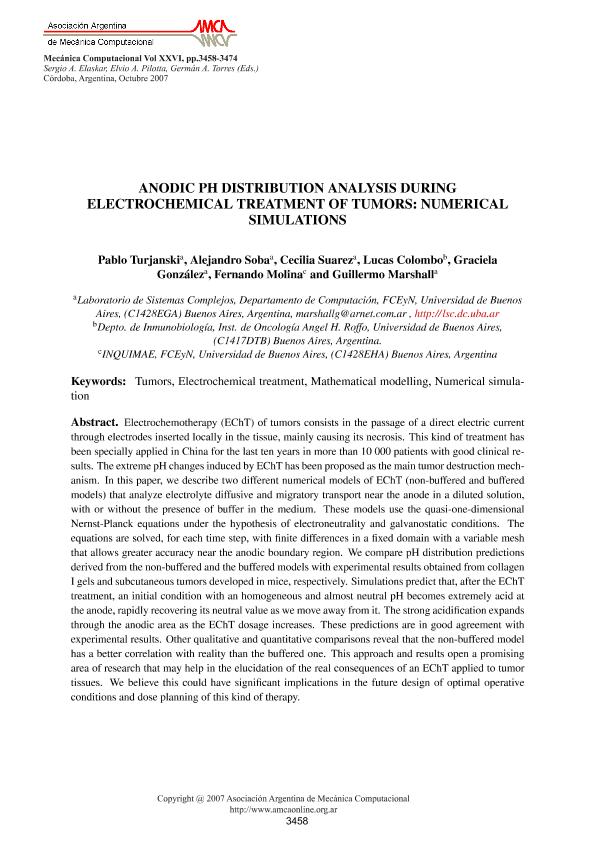Artículo
Anodic ph distribution analysis during electrochemical treatment of tumors: numerical simulations
Turjanski, Pablo Guillermo ; Soba, Alejandro
; Soba, Alejandro ; Suarez, Cecilia; Colombo, Lucas Luis
; Suarez, Cecilia; Colombo, Lucas Luis ; González, Graciela; Molina, Fernando Víctor
; González, Graciela; Molina, Fernando Víctor ; Marshall, Guillermo Ricardo
; Marshall, Guillermo Ricardo
 ; Soba, Alejandro
; Soba, Alejandro ; Suarez, Cecilia; Colombo, Lucas Luis
; Suarez, Cecilia; Colombo, Lucas Luis ; González, Graciela; Molina, Fernando Víctor
; González, Graciela; Molina, Fernando Víctor ; Marshall, Guillermo Ricardo
; Marshall, Guillermo Ricardo
Fecha de publicación:
12/2007
Editorial:
Asociación Argentina de Mecánica Computacional
Revista:
Mecánica Computacional
ISSN:
2591-3522
Idioma:
Inglés
Tipo de recurso:
Artículo publicado
Clasificación temática:
Resumen
Electrochemotherapy (EChT) of tumors consists in the passage of a direct electric current through electrodes inserted locally in the tissue, mainly causing its necrosis. This kind of treatment has been specially applied in China for the last ten years in more than 10 000 patients with good clinical results. The extreme pH changes induced by EChT has been proposed as the main tumor destruction mechanism. In this paper, we describe two different numerical models of EChT (non-buffered and buffered models) that analyze electrolyte diffusive and migratory transport near the anode in a diluted solution, with or without the presence of buffer in the medium. These models use the quasi-one-dimensional Nernst-Planck equations under the hypothesis of electroneutrality and galvanostatic conditions. The equations are solved, for each time step, with finite differences in a fixed domain with a variable mesh that allows greater accuracy near the anodic boundary region. We compare pH distribution predictions derived from the non-buffered and the buffered models with experimental results obtained from collagen I gels and subcutaneous tumors developed in mice, respectively. Simulations predict that, after the EChT treatment, an initial condition with an homogeneous and almost neutral pH becomes extremely acid at the anode, rapidly recovering its neutral value as we move away from it. The strong acidification expands through the anodic area as the EChT dosage increases. These predictions are in good agreement with experimental results. Other qualitative and quantitative comparisons reveal that the non-buffered model has a better correlation with reality than the buffered one. This approach and results open a promising area of research that may help in the elucidation of the real consequences of an EChT applied to tumor tissues. We believe this could have significant implications in the future design of optimal operative conditions and dose planning of this kind of therapy.
Archivos asociados
Licencia
Identificadores
Colecciones
Articulos(INQUIMAE)
Articulos de INST.D/QUIM FIS D/L MATERIALES MEDIOAMB Y ENERGIA
Articulos de INST.D/QUIM FIS D/L MATERIALES MEDIOAMB Y ENERGIA
Articulos(OCA HOUSSAY)
Articulos de OFICINA DE COORDINACION ADMINISTRATIVA HOUSSAY
Articulos de OFICINA DE COORDINACION ADMINISTRATIVA HOUSSAY
Citación
Turjanski, Pablo Guillermo; Soba, Alejandro; Suarez, Cecilia; Colombo, Lucas Luis; González, Graciela; et al.; Anodic ph distribution analysis during electrochemical treatment of tumors: numerical simulations; Asociación Argentina de Mecánica Computacional; Mecánica Computacional; XXVI; 40; 12-2007; 3458-3474
Compartir



